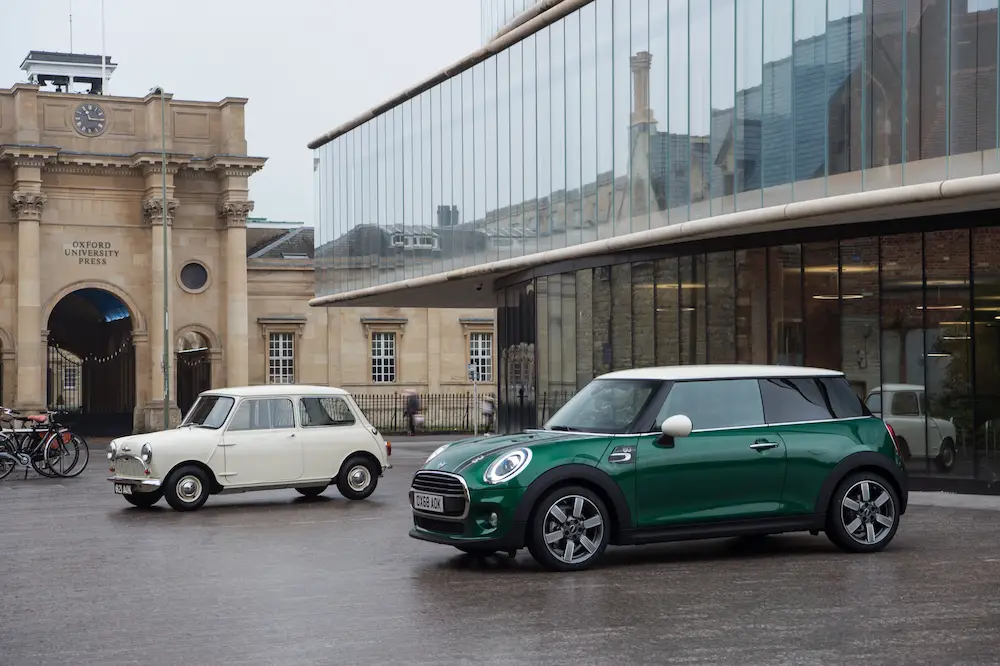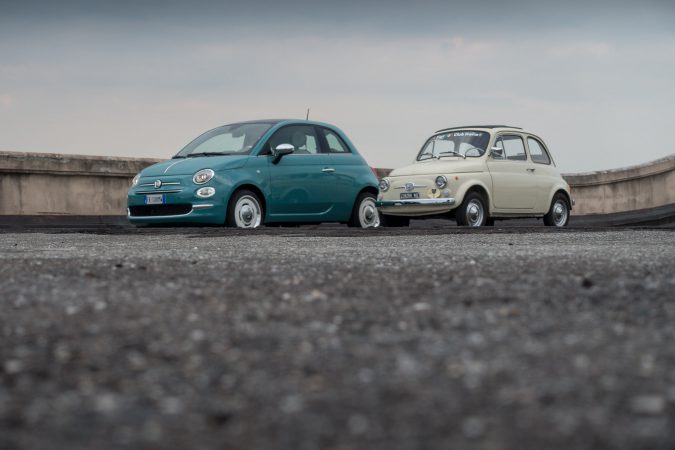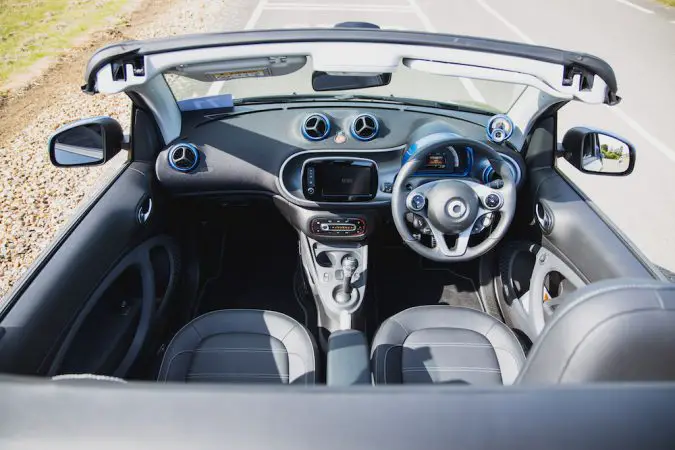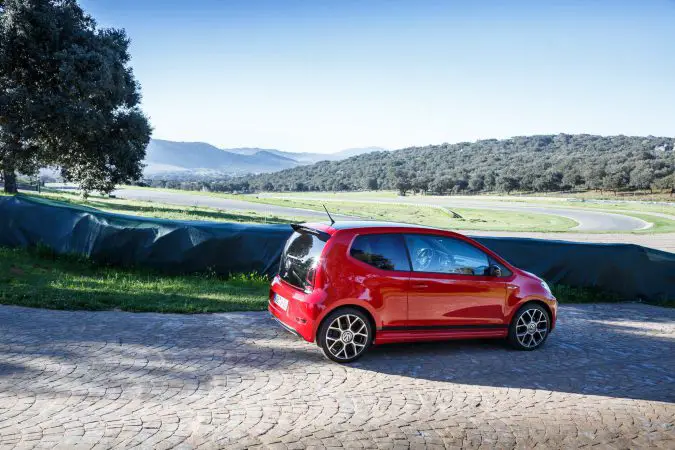Wondering what’s the smallest car in the world? You’d be surprised how small the smallest car in the world can get. You’ll probably wonder if it’s even safe to drive it. Curious? We’ve got the answer down below, along with some other small cars. Get ready to get into the (small) world of weird and wonderful small cars:
Smallest Car In The World: The Peel P50
If you’re an avid fan of Top Gear, you’re probably no stranger to the Peel P50. It was featured in an episode of Top Gear back in 2007. Jeremy Clarkson drove it around London and drove through the BBC’s Television Centre. You read that right, he drove it through the building, not just to the building. It’s that small!
The Peel P50 was relatively unknown. But Top Gear arguably brought it to the limelight all on its own, and it captured the attention of gearheads around the world – or at least, where Top Gear UK was broadcasted. Take a look:
The P50 was made by the Peel Engineering Company on the Isle of Man, a self-governing British Crown Dependency island. It was originally made from 1962 to 1965. And they market it as a city car that’s capable of seating one adult and a shopping bag.
With a wheelbase of just 50 inches long, it still holds the title of the smallest car in the world. It was also why they named it the P50. And it was about 38 inches wide and 39 inches tall. Despite the small size, it was able to fit all six foot five of Jeremy Clarkson which is mighty impressive.
Meanwhile, the engine is a single-cylinder 50cc engine making a whopping 4.2 horsepower. And the top speed was a dizzying 38mph. Not a lot, but considering it only has three wheels and is about as tall as a small child, you probably won’t want any more speed.
Believe it or not, it’s street-legal and always has been. It’s street-legal in the UK, being in the three-wheeler category. And is street legal in the US as well, along with other countries, and it’s classified as a moped in certain countries.
The Peel Trident
We’d like to mention the P50’s less-known bigger brother: the Peel Trident. It was slightly larger at around 73 inches in length, and 39 inches wide. This meant there was space for a passenger, although the concept of personal space would cease to exist should you have someone with you in the car.
The Trident also has three wheels and uses the same 50cc engine as the P50, making a healthy 4.2 horsepower. Although some models are equipped with a 99cc engine from the Triumph Tina scooter.
The most interesting part about the Trident is that it doesn’t have a door. Rather, the top part of the car opens to allow the driver to get in and out of the car. Additionally, it has an aircraft-style bubble canopy rather than a roof. This will essentially cook you on hot summer days, but it looks nice and gives you a nice view kind of like a panoramic sunroof would.
As mentioned, the Trident is larger than the P50. So, the P50 still holds the record for the smallest car in the world. But the Trident is also an interesting piece of automobile history that’s worth mentioning.
How Much Does The Smallest Car In The World Cost?
It was very cheap when new, as you’d expect. Since it didn’t use a lot of materials, the Peel P50 costs just £199 when new, or around $8,500 in today’s money. However, only 50 of the original P50 was made, so they’re quite rare now and can fetch a much higher price in an auction.
One example from Sotheby’s was sold for $62,000. While several units have fetched a price of $120,000 in auctions. That’s twice the price of what you would pay for a base model Porsche 718 Boxster. And frankly, we’d rather have the Boxster.
Can I Buy The Smallest Car In The World?
Surprisingly, you can. In 2011 businessmen by the name of Gary Hillman and Faizal Khan got an investment of $80,000 from the Dragons’ Den TV show. They own the Peel Engineering company and used the money to make modern interactions of the P50. If you don’t want to pay hundreds of thousands of dollars for a Peel P50, they’re your answer.
They come in two versions: gas or electric, along with the Peel Trident. The electric version uses a brushless DC electric motor, making 3 horsepower. While the gas version uses a 50cc four-stroke engine with a CVT transmission. They’re made to order and cost around £14,000 ($18,660) in the UK, which is around the same price as a new compact hatchback.
Interestingly, another company also makes modern iterations of the P50. They’re called P50CARS and seem to be owned by Pendine Motors rather than Peel Engineering. Their website states that they make a faithful homage, rather than reproducing the original P50.
The biggest difference is that they only come with electric motors, so no gas engine options. Also, they have self-assembly kits. This means they will give you all the components including the motor, and you can build it yourself for just £7,495 ($9,989). As opposed to the $14,000 pre-built car.
However, they are also made to order, just like the ones made by Peel Engineering. Additionally, they’re based in the UK, so you’ll have to pay attention to vehicle import regulations.
Smallest Car In The World: Honorable Mentions
While the P50 is technically the smallest car in the world, it barely makes the cut on what we generally consider a car. When you think of a car, you don’t typically think of a 50cc engine with three wheels and a single headlight.
There are other small cars – albeit bigger than the P50. But they have four wheels and more seats, so they’re more in tune with what we generally consider a car. Here are some other really small cars that we think deserve an honorable mention:
1. The Original Mini Cooper
We start with the most iconic of them all: the original Mini Cooper. BMW owns MINI nowadays, and while they’re still fun hot hatches, one thing is for sure: they’re not small anymore. Definitely nowhere near as small as the original car.
The original car has a wheelbase of just 80.2 inches long. And is around 55 inches wide and 53 inches tall. While the P50 weighs just 123lb, the Mini weighs around 1,300lb.
Of course, the Mini was more of a car than the P50. It has four wheels, a four-cylinder engine, and four seats. Despite the small size, the original Mini was still practical.
It’s mostly thanks to its transversely-mounted engine with a transmission that was incorporated into the engine’s sump. This meant the engine was more compact, quite the innovation at the time.
Additionally, it was front-wheel drive. So, there was no need for a driveshaft to run through the car and take up cabin space. Of course, practicality isn’t the only selling point of the Mini, it was mostly about the way it drives.
The small size and the compact engine meant it would fly through the corners. The engine isn’t powerful, especially the early 850cc ones, but it handles like a front-wheel drive go-kart with a roof.
As someone who used to own a Mini, believe me when I say that there’s nothing quite like it. Your life as a car enthusiast is not complete if you haven’t driven a Mini. Okay, that may be a bit of an exaggeration, but it is that good.
Of course, I’m not the only one who appreciates the Mini, so it’s a highly sought-after classic nowadays. They start at around $15,000, but certain examples in a prime condition can cost up to $53,000.
2. The Original Fiat 500
Like the Mini Cooper, the Fiat 500 is an old car that’s still being made today. While the modern Fiat 500 is still quite small, it’s nowhere near as small as the original car. And while the original Mini was small, the Fiat 500 was even smaller. And yes, it can also fit four people in it.
The Fiat 500 was made from 1957 to 1975, and then it was revived in 2007. What you might not know is that there was a Fiat 500 “Topolino”, which was a small economy car in the 1930s, but we’re not talking about that as it’s nowhere near as popular as the 1950s Fiat 500.
Much like the Mini, the Fiat markets the Fiat 500 as an economy car for the masses. Its sole purpose was to be as small as possible so that it would use less material, making it cheap to buy for consumers. Its wheelbase was only 72.4 inches long, and it measures 52 inches wide and tall.
It has two doors, four seats, and a two-cylinder engine at the back. Quite similar to the original VW Beetle. Engine choices include a 480cc, 500cc, and a 600cc engine that makes a massive 17 horsepower.
We may think of it as a cute, small, classic car. But it was made to meet the demands of the time, where Italian consumers wanted a personal vehicle for cheap but can still accommodate a small family.
The Fiat 500 is an important part of automobile history and is one of the smallest cars in the world. They’re not very common in the US, but some examples cost around $20,000. While not as exciting as the Mini, there are Abarth versions such as the Abarth 695 SS.
3. BMW Isetta Bubble Car
The bubble car is a sub-category of microcars that had aircraft-style bubble canopies, similar to the Peel Trident we mentioned earlier. It was quite popular in 1950s Germany, partly because of its excellent fuel consumption. And partly because you were legally able to drive this car with just a motorcycle license.
The Isetta was actually made by multiple manufacturers. The original manufacturer was Iso Autoveicoli, an Italian carmaker. They then sold the rights and tooling to make the Isetta to multiple companies. Including VELAM, which made the car for the French market. De Carlo for Argentina, and Romi for Brazil. And of course, the most well-known version is BMW’s.
Other manufacturers simply manufactured the Isetta for their local market. However, BMW redesigned the powerplant using an existing BMW one-cylinder engine. While the car looks about the same, a lot of the components are BMW’s own and not interchangeable with other Isettas.
There are two versions of the car, the BMW Isetta 250 and Isetta 300. The former makes just 12 horsepower. While the latter has a 300cc single-cylinder 4-stroke engine making 13 horsepower. Paired with a 4-speed manual transmission that – unlike the original P50 – has a reverse gear. That’s good for a top speed of about 53mph.
There are surprisingly quite a few of them in the US, and they can fetch a pretty penny. They cost anywhere between $30,000 – $50,000, and we found one that’s asking for $59,000, that’s the list price of a new BMW M2.
Unlike the new BMW M2, we don’t imagine the Isetta is as fun to drive. But it is good for a laugh and is a charming little car. Unlike our next entry:
4. Renault Twizy
Let’s move on to something more modern, shall we? This brings us to the Renault Twizy, which is probably the only small car in production today that resembles microcars such as the P50 and the BMW Isetta. While it’s technically a microcar, it classifies as a quadricycle in Europe.
It has two seats; one for the driver, one for the passenger right behind it. Four seats, headlights, two doors (as an option), a steering wheel, an electric motor, and that’s about it. The motor sits at the back, driving the rear wheels. And it has a 6.1kWh battery pack, which gives it a range of about 50 miles. If you’re careful.
Since the range is so small, it’s meant to be a city car for quick drives. Such as for going to the shops or maybe for running a quick errand for example. The Renault Twizy comes in three different versions, with the cheapest one costing €6,990 ($7,887), making it the cheapest electric car on sale. And no, you don’t get a door as standard.
As you’d expect, the Twizy isn’t sold in the US, since Renault doesn’t sell cars in the US in the first place. And to be honest, the US market isn’t missing anything. It’s an interesting little car, but it doesn’t have quite the charm of those old microcars such as the P50 and the BMW Isetta.
5. Smart Fortwo
Probably the only modern car that’s almost as small as those old microcars, and yet still comfortable to drive: the Smart Fortwo. Daimler (through Mercedes-Benz) made the original car in 1998. The recipe was a two-door, two-seater car, with a turbocharged three-cylinder engine sitting at the back.
It made a decent 45 horsepower, which was plenty for a car that weighs just a little over 1,600lb. There were coupe and cabriolet models, and all of them come with a 6-speed automated manual transmission. It’s not the best-looking car, nor is it the fastest or most exciting, but it was a lot smaller than anything else on the market.
With a total length of just 98.4 inches, you can technically park the Smart Fortwo head on to the curb. Although this is a bit of a grey legal area. Anyway, despite the small size, it was still able to fit two people in comfort, with plenty of luggage space. And unlike the Twizy, the gas engine means you can drive the Smart Fortwo long distances.
Daimler still makes the Smart Fortwo, with Mercedes handling the distribution and after-sales service. The latest generation still keeps the original formula, although they are slightly longer nowadays at around 106.1 inches. Engine options include a 900cc turbocharged three-cylinder, 1.0L engineer, and an electric version with a 66kW electric motor.
However, gas engine versions are no longer available since 2018. The brand was also rebranded as the Smart EQ, to align with the Mercedes EQ brand which is reserved for electric cars. Additionally, it’s no longer available in the US as of 2019. Most likely due to poor sales and low demand, which brings us to why modern cars are so big:
Why Are Modern Cars So Big?
Okay, so small cars are still around. The Smart Fortwo is still in production, and carmakers still make plenty of small cars, mostly for the Asian and European markets. Examples include the Mitsubishi Mirage, Honda Fit (meanwhile, make sure you’re wary fo the best year for Honda Fit), and VW Up! (yes, the name is stylized with the exclamation mark).
But why do cars like the Peel P50 and the Isetta no longer exist? Simply because no one wants them. We all want more space in our cars nowadays, be it for passengers, luggage, or for our own personal comfort. No one wants to drive in a cramped single-seater Peel P50. At least, not on a daily basis.
This is especially true in the United States. Mercedes stopped selling the Smart Fortwo in the US because no one bought them. And cars like the VW Up! or the Renault Twizy were never sold in the US because there was no such need.
Unlike in Europe or some parts of Asia, US roads and streets are massive, able to accommodate even the largest trucks. There’s no need for smaller cars to make driving easier.
Additionally, modern cars have to meet safety regulations. This means they need multiple safety features, such as airbags. Not to mention, passing crash tests means the design will need to incorporate good crumple zones to absorb the impact, making the car safer. And you can’t design that without making the car bigger.
Finally, we car buyers want all sorts of features and amenities. From air conditioning, excellent stereo speakers, and all sorts of electronics to make driving life better and easier. You can’t add all this without increasing the size of the car to accommodate it.
What Small Car Can I Buy?
While you can’t buy those really small microcars anymore, there are still some reasonably small cars out there you can buy. Here are some of the smallest cars you can find in the US market:
- Chevrolet Spark. Measuring at just 143.1 inches long, this is as small as you can get with any new car in the US. Starts at just around $14,000, it comes with a four-cylinder engine and either a 5-speed manual or a CVT.
- MINI Cooper 3-Door Hatchback. Despite being way larger than the original car, it’s still one of the smallest cars you can buy in the States. It measures 151.1 inches long and starts at around $20,000. While the higher-performance JCW versions start at around $30,000.
- Mitsubishi Mirage. Available as a sedan or a hatchback, we recommend skipping this one. It’s slow, unrefined, and has one of the cheapest build-quality in the market. Car and Driver gave it a lowly rating of 2.5 out of 10. We’re only listing it as it’s very small, at just 151.4 inches long. It is cheap though, starting at just around $15,000.
- Mazda MX-5. This one we can recommend, it’s one of the best small sports cars out there. Sure, at 154.1 inches it’s quite a bit bigger than the other cars we’ve mentioned, but it is a wonderful little thing to drive. Yours for a reasonable $28,000.
- Smart Fortwo. Okay, so the Smart Fortwo is no longer on sale in the US. But they’re the closest thing we have in the modern age to those tiny microcars. And they were still selling it up until 2019, which means you can still find a relatively new one. Additionally, Mercedes-Benz will still provide after-sales service. You can pick one of the electric versions for around $14,000 in the secondhand market.
Microcars: 10 Need-to-Know Facts
- Shuanghuan Noble looks like Daimler’s Smart Fortwo, and Daimler sued Shuanghuan over alleged Smart ForTwo knockoffs.
- Corbin Sparrow Jelly Bean has only one door and seat and can reach speeds up to 75 mph, but it’s not one of the safest.
- Iso Rivolta developed the Iso (BMW) Isetta with a 236cc 2-stroke engine, the world’s first mass-produced car capable of 78 mpg.
- The Norwegian-made Buddy has a bench seat and is famous for coming in bright colors.
- The Indian-made REVAi is a tiny three-door hatchback, also known as G-Wiz in the UK, with over 4,000 units sold by March 2011.
- The original 1957 Fiat 500 was produced to feed the post-WWII market, with excellent fuel efficiency and handling, including a sports version produced by Abarth.
- The Piaggio Vespa 400 was designed by the Italian car manufacturer ACMA, with a small engine that produced only 12 horsepower.
- The Australian-made Goggomobil Dart was spacious enough to ensure passenger comfort, but the gauge cluster consisted of just one circle.
- Elektromaschinenbau Fulda GmbH made Fuldamobils, the first cars to have a negative scrub radius, and gave rise to the term “bubble car.”
- The Commuter Cars Tango is a micro sports car that costs $108,000, with serious owners like George Clooney and Eric Schmidt, the Google CEO.
- The Think City is an electric city car from Norwegian auto manufacturer Think Global, with a decent top speed of 68 mph and a range of 99 miles on a full battery.
- The Mitsubishi 360 was a front-engine, rear-wheel-drive tiny pickup truck produced in the 1960s.
- The Peel P50 is a one-door coupe that delivers 3.15 horses on average and does not have a reverse gear.
Smallest Car In The World: Wrap Up
So, now you know what the smallest car in the world is: the Peel P50. Peel also makes the Trident, which is slightly bigger so the title of the smallest car in the world still goes to the P50. But with an aircraft-style bubble canopy, you can’t deny the Trident is pretty cool. This knowledge will surely come in handy the next time you’re trying to break the ice during a first date.
There are many, many more small cars we haven’t mentioned. In fact, Japanese carmakers made a lot of cool small sports cars back in the 90s and early 2000s. Such as the Daihatsu Copen, the Suzuki Cappuccino, and the striking Mazda Autozam AZ-1.
However, they are not nearly as small as even the original Mini Cooper or the Fiat 500, let alone the Peel P50. We’ll probably discuss these cars in a different article in another day.




